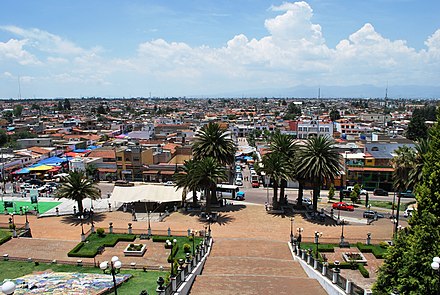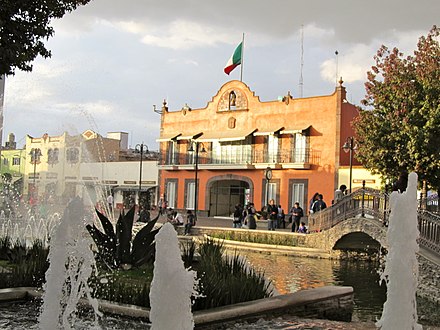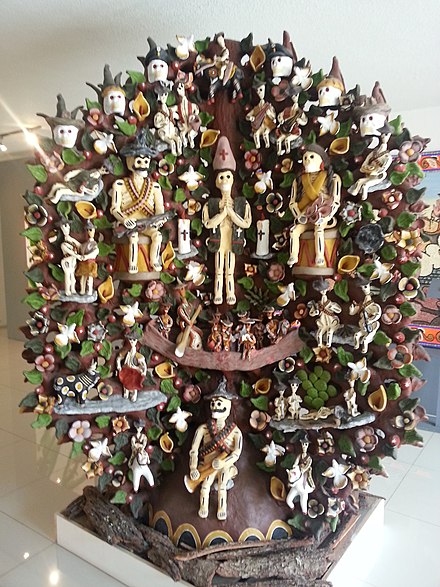Metepec - city in Metepec Municipality, Mexico State, Mexico
Metepec is a tourist town of 28,000 people (2019) in southeast Toluca. It is known mainly for its quaint streets and commerce.
Understand
The city center lies at the foot of the hill that gives the city and municipality its name. There has been a community here since the Otomis and Matlatzincas settled in this part of the Valley of Toluca: the Matlatzincas reached their cultural peak between AD 1120 and 1450 as part of the Teotihuacan culture.
Get in

Get around
See
 Downtown Metepec has the feeling of a small, historic Mexican town. The charming centre is rife with small cafes, restaurants, bars, and stores selling local arts and crafts.
Downtown Metepec has the feeling of a small, historic Mexican town. The charming centre is rife with small cafes, restaurants, bars, and stores selling local arts and crafts.
Get a good view of the city and surrounding area by climbing the Cerro de Maguey, the hill at the centre of the city.
The Ex-convento de San Juan is the main religious structure in the town and dates from the 16th century; however, other churches worth visiting include Las Capillas de El Calvario, La Santa Cruz, del Espíritu Santo, San Bartolomé, de San Salvador, de Santa María Magdalena and la Parroquia de San Mateo.
- Museo del Barro, Av. Estado de Mexico 10, 19.251303°, -99.597991°. 10ː00 - 18ː00. Small museum focused on popular folk arts, especially the clay ceramics made in Metepec. The second floor features a number of ceramic artesanias with a lot of catrinas and a lot of trees of life, some spectacularly off beat....do you still call it a "tree of life" if all the figures on it are skeletons? A museum store is on the lower level selling very good quality ceramic art. 2023-01-15
Do
Walk around town and check out the shops and restaurants. For its small size, there is a considerable number of trendy bars.
The 24th of June is the feast day of Metepec's patron saint, John the Baptist. The city has an international arts and culture festival called Quimera, which occurs in October.
Buy
 Metepec is known for its pottery items and it is still of economic importance. The artisans of this area have organized into the Asociación de Artesanos de Metepec y la Unión de Alfareros de Metepec, A.C. (Association of Artisans of Metepec and the Union of Potters of Metepec). Principal crafts include objects made from clay, glass and includes saddlemaking. The city has about 300 craftsmen and 275 family workshops. The craft Metepec is best known for is the Arbol de la vida ("Tree of Life") which is a traditional pottery representation of the tree from which Adam and Eve ate in the Biblical story. The album cover of the Beatles' 1967 record Sgt. Pepper's Lonely Hearts Club Band features a Metepec Tree of Life.
Metepec is known for its pottery items and it is still of economic importance. The artisans of this area have organized into the Asociación de Artesanos de Metepec y la Unión de Alfareros de Metepec, A.C. (Association of Artisans of Metepec and the Union of Potters of Metepec). Principal crafts include objects made from clay, glass and includes saddlemaking. The city has about 300 craftsmen and 275 family workshops. The craft Metepec is best known for is the Arbol de la vida ("Tree of Life") which is a traditional pottery representation of the tree from which Adam and Eve ate in the Biblical story. The album cover of the Beatles' 1967 record Sgt. Pepper's Lonely Hearts Club Band features a Metepec Tree of Life.
Monday is market day in the city centre, called plaza, where merchants go to sell fruit, vegetables and even a few electronic items. There are also lots of stores selling hip furniture and home decorations.
Galerías Metepec is a shopping center and department store that is open every day.
Eat
While most of the food in Metepec is typical of the region (with dishes such as barbacoa, tamales, and huaraches) it does have a unique drink called "Garañona". It is made from 15 herbs and is a strong, sweet drink. Some locals say it is an aphrodisiac. The only place that sells and distributes this drink is a bar called the 2 de Abril in the city center.
For delicious homemade food for little money, try one of the many 'cocina familiares'. La Pasadita, beside Chedraui on Guadelupe Victora is a bit of a hike from the center, but offers a complete meal for approximately M$35.
Surrounding the main plaza are several small restaurants offering local food.
Several chain, high class, and fast food restaurants can be found in Galerias Metepec.
La Forja, located a block east of the main plaza, offers fine cuisine, excellent atmosphere, and an impressive wine list.
Drink
- Espacio Gastronomico Metepec. 2018-04-05
Sleep
Connect
Go next
Metepec
metepec.gob.mxPostal code:52140Date Time:Please wait...Timezone:America/Mexico_CityPopulation:30,203Coordinates:19.25, -99.60
Metepec
2nd-order administrative division
State of Mexico
Primary administrative division